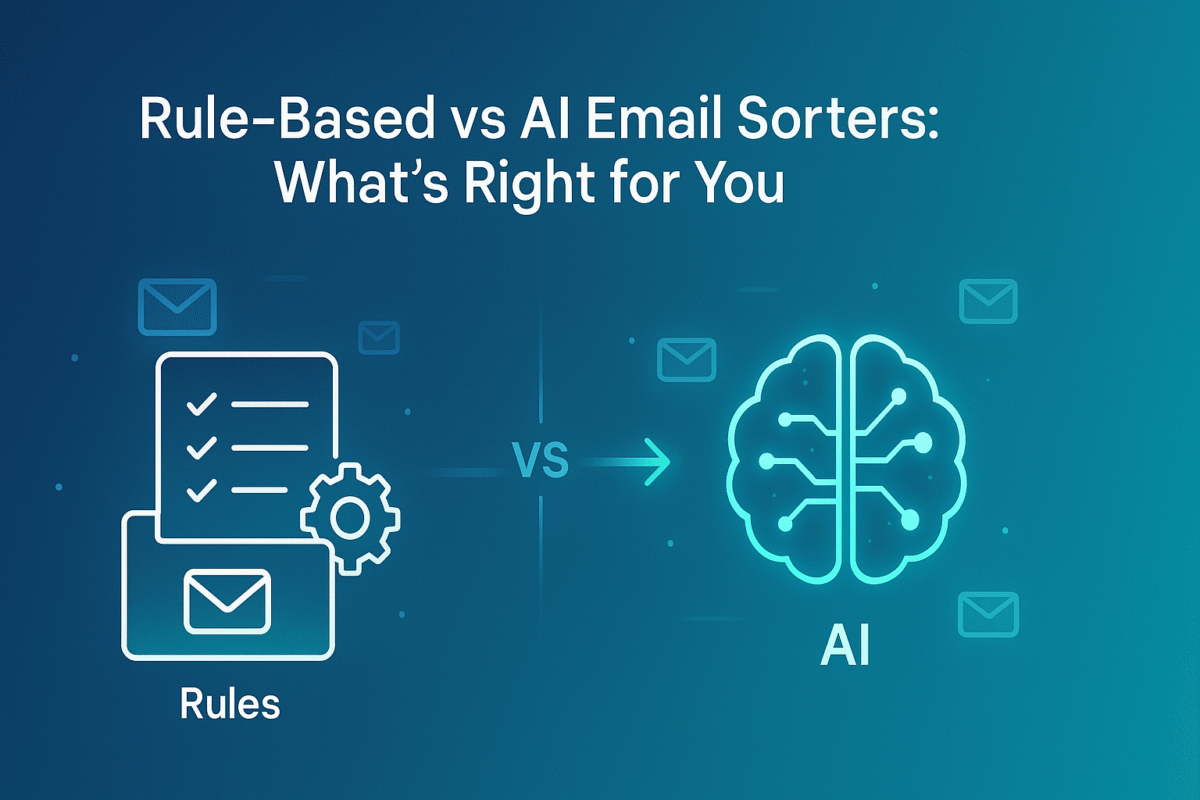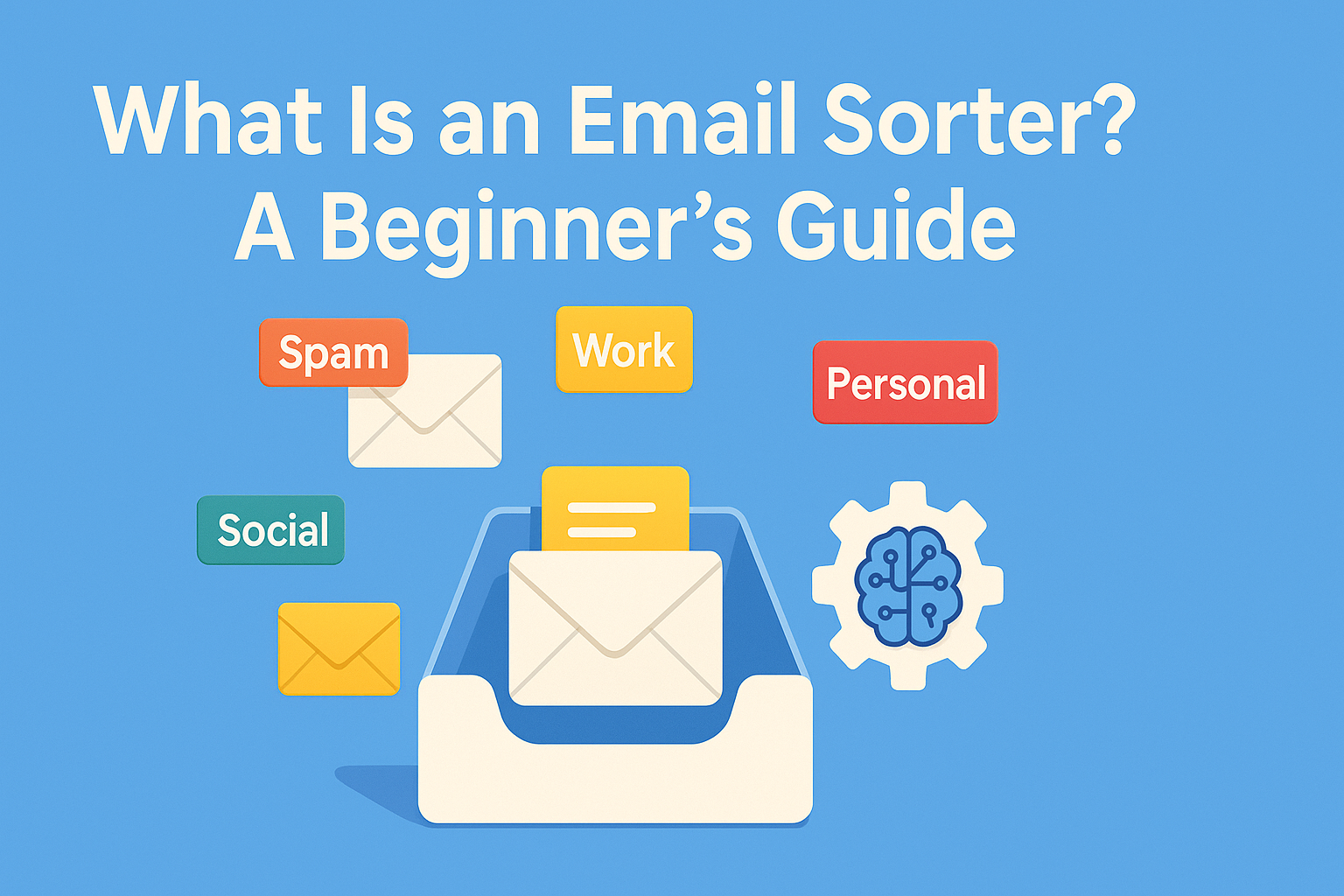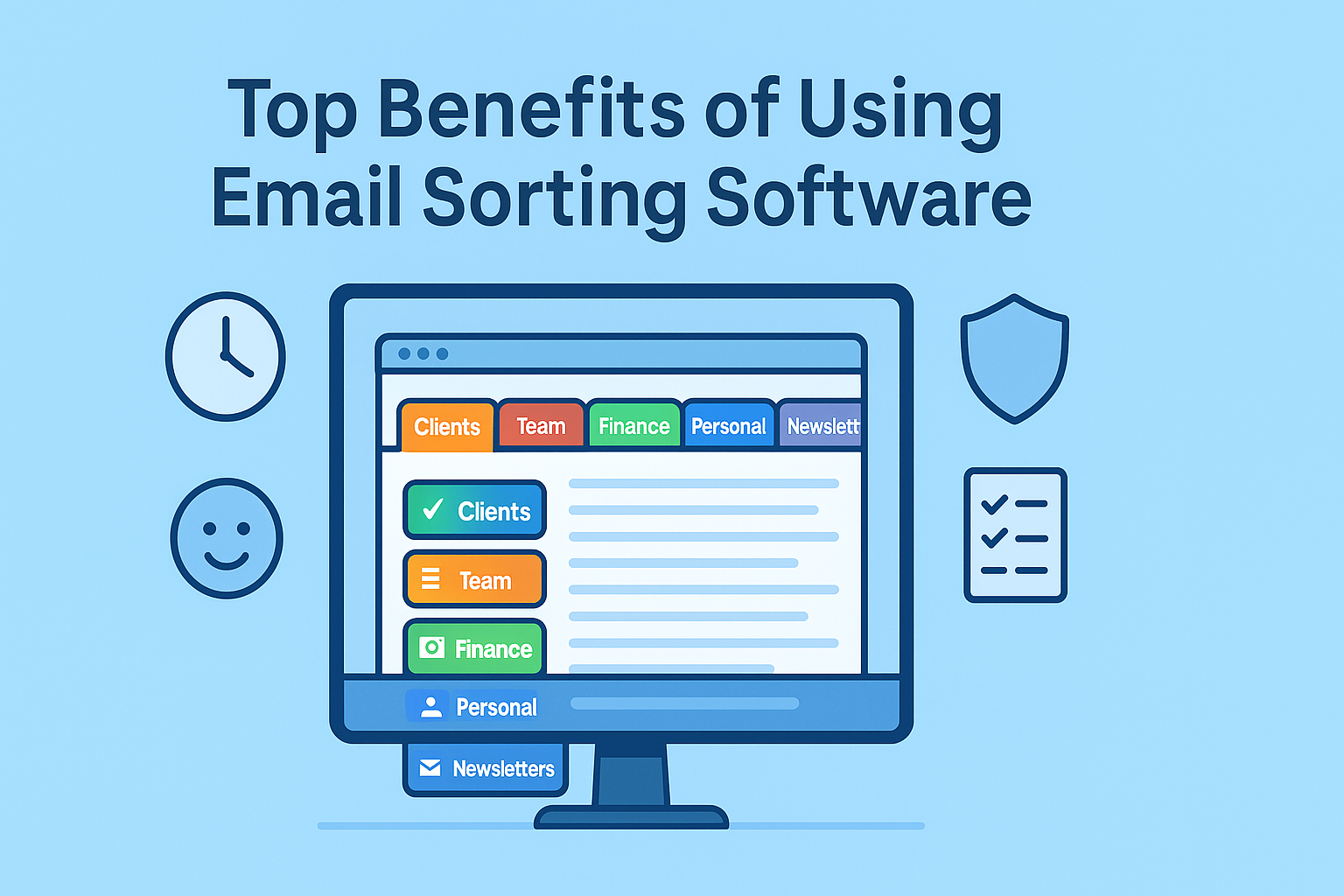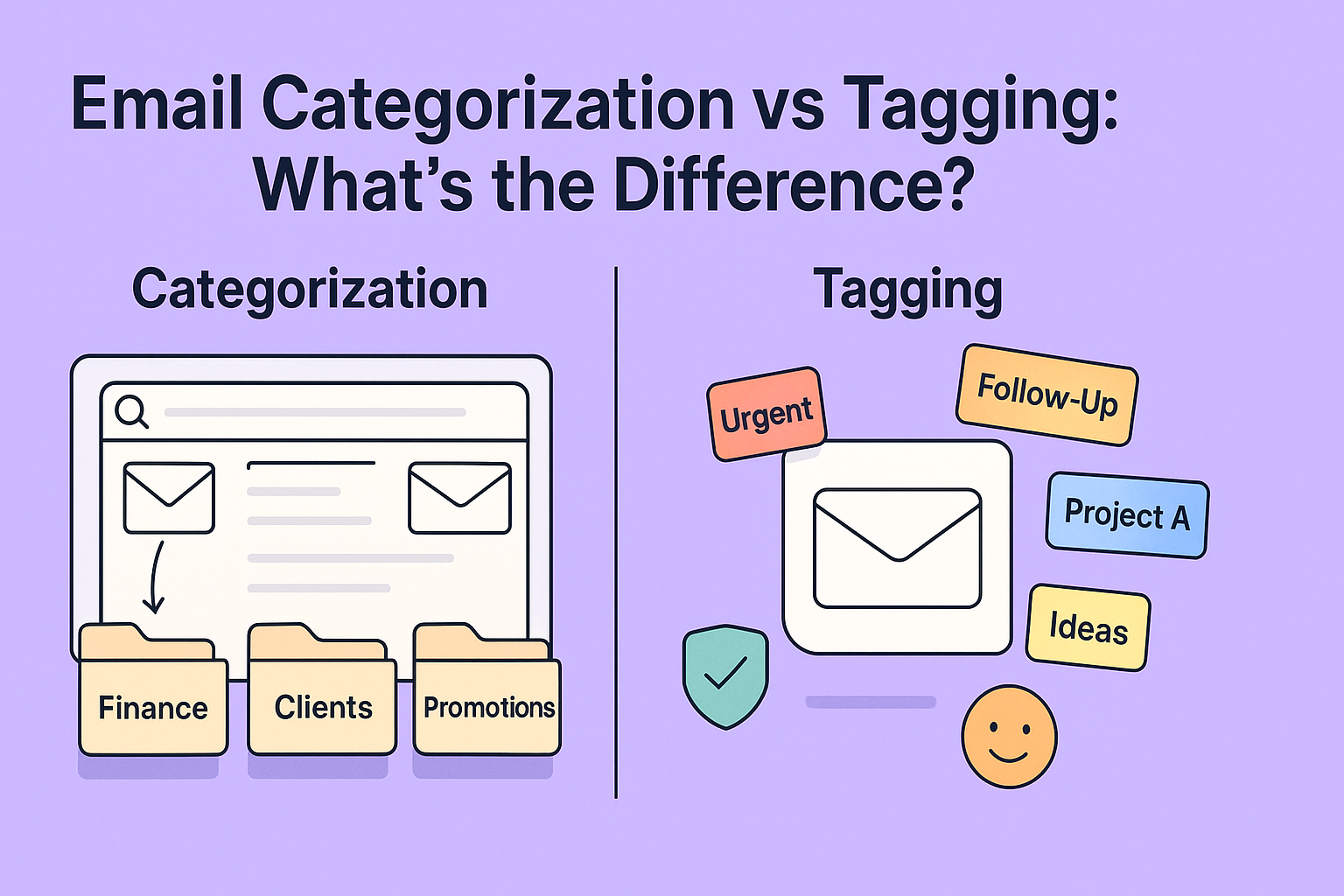An intelligent email sorter can totally change how you handle your inbox, but should you pick a rule-based system or an AI-powered one? The choice can feel tricky, and it might leave you wondering which option really fits your workflow best. The right email sorter can save you hours and keep your inbox stress-free, but only if it matches how you like to work. Ready to figure out which style suits you? Let’s dive into the world of rule-based vs AI email sorters and find the perfect fit.
The Ongoing Challenge of Managing Email
Email was supposed to make communication simpler. But for many professionals, it’s become a daily grind,full of clutter, spam, and endless notifications. Managing emails takes time, focus, and mental bandwidth. Whether you’re handling a few dozen messages or hundreds each day, finding the right system to stay organized is more important than ever.
You’ve likely tried folders, filters, maybe even hired an assistant, or at least wished you had. But the real question remains: should you use traditional rule-based tools to sort your inbox, or is it time to let AI handle the mess?
This comparison is more than just tech talk. It’s about choosing the right strategy for how you work. Because the wrong tool can waste time, bury important emails, and leave you feeling overwhelmed. The right one can make your inbox feel manageable again.
Why the Right Sorting Tool Matters
Not all email is created equal. A message from your accountant isn’t the same as a weekly newsletter. Some emails demand instant replies. Others are FYI. That’s why sorting tools matter, they help you separate what’s urgent from what’s noise.
Rule-based and AI-powered systems take different paths to solve the same problem: too much email, too little time. Understanding how each works and what they’re good at can help you choose the one that fits your workload, personality, and expectations.
What Are Rule-Based Email Sorters?
Rule-based email sorters organize your inbox using specific, pre-set rules. These rules can be based on things like the sender, subject line, keywords, or email age. When an email matches a rule, the sorter automatically moves, labels, or flags it according to the instructions you set. This helps you keep your inbox organized without manually sorting every message.
How They Work
Rule-based email sorters operate on a simple logic system: if this, then that. If an email is from a certain sender, move it to a folder. If the subject contains a specific word, mark it as important. These systems rely entirely on the conditions you set up in advance.
They’re deterministic, meaning they always behave the same way once a rule is in place. The behavior doesn’t change unless you update the rule. It’s like teaching a dog to sit—but it will only sit when it hears that one exact command.
Common platforms like Gmail, Outlook, and Apple Mail all have built-in rule-based sorting tools. You can create filters based on sender, subject, content, attachments, and more. Once configured, the system does the sorting automatically.
Common Features
Rule-based sorters offer a range of options, including:
- Filtering by sender address or domain
- Sorting by keywords in subject or message body
- Moving, archiving, or flagging emails
- Forwarding or auto-replying based on conditions
- Assigning labels or categories
These features can be highly effective in simple, repetitive workflows. If you always want receipts in one folder or client emails highlighted, rules make that happen without extra steps.
When Rule-Based Systems Are Most Effective
Rule-based sorters shine when your email patterns are predictable. If you receive regular messages from known sources like automated reports, monthly invoices, or team updates, setting a rule once can save you hours over time.
They’re also perfect for people who want full control. You decide exactly what happens, and the system does it. No guesswork. No AI “interpreting” your intent.
But they have a ceiling. Once your email habits get more complex or if you need the system to learn and adapt rules start to feel limited. That’s when AI steps in.
What Are AI-Powered Email Sorters?
AI-powered email sorters use artificial intelligence to automatically organize your inbox. Instead of relying on fixed rules, they learn from your behavior and patterns to decide which emails are important, spam, or need quick attention. They can understand context, prioritize messages, and adapt over time to improve how your emails are sorted without much manual setup.
How They Work Differently
AI email sorters don’t rely on fixed conditions. Instead, they use machine learning and natural language processing to analyze the content, context, and your behavior. They watch how you interact with emails that you read, ignore, delete, or respond to and use that information to improve over time.
These systems evolve. They learn that emails from your manager should be flagged, even if the subject line changes. They recognize patterns, like your tendency to archive newsletters without reading them. And they adjust their sorting based on what they’ve observed.
Unlike rule-based sorters, you don’t have to tell AI tools exactly what to do. You just have to keep using your inbox the way you normally would, and the system gradually improves its accuracy.
Key Capabilities
Here’s what sets AI email sorters apart:
- Content-aware filtering: Sorts emails based on actual message meaning, not just keywords
- Priority learning: Flags or highlights emails it learns are important to you
- Behavioral analysis: Learns from your open, click, and reply habits
- Smart replies: Suggests responses based on the tone and content of the message
- Adaptive scheduling: Reminds you to reply or follow up based on urgency patterns
These tools don’t just organize your inbox, they actively help you manage your communication flow, so you can focus on high-impact tasks.
When AI Tools Make the Biggest Impact
AI sorters excel in environments with high email volume, mixed priorities, or constantly shifting responsibilities. They’re ideal for:
- Managers juggling multiple projects
- Freelancers handling different clients
- Support teams with dozens of daily threads
If your inbox feels like a puzzle you’re constantly solving, AI can help you stop managing email manually and start focusing on what matters.
Comparison Table Rule-Based vs AI Email Sorters
Here’s a clear and concise comparison table summarizing the key points from your detailed content on Rule-Based vs AI Email Sorters:
| Feature / Aspect | Rule-Based Email Sorters | AI-Powered Email Sorters |
| How They Work | Use fixed, pre-set rules (if this, then that) | Use machine learning to analyze email content and behavior |
| Setup & Maintenance | Requires manual setup and regular rule updates | Minimal setup, learns and adapts automatically over time |
| Customization | Highly customizable with specific rules | Flexible and adaptive, learns from your email habits |
| Accuracy | Accurate when rules match, but breaks if conditions change | Improves accuracy over time by learning from patterns |
| Adaptability | Rigid; rules must be updated if email patterns change | Flexible; adjusts to new senders, topics, and formats |
| Ease of Use | More upfront effort and micromanagement | Easy to use; requires little manual intervention |
| Handling Complex Sorting | Limited; struggles with unpredictable or new email types | Excels at complex prioritization and context understanding |
| Ideal For | Users with predictable, repetitive email patterns | Users with varied, high-volume, or changing inbox needs |
| Common Use Cases | Simple workflows, consistent senders (e.g., invoices) | Managers, freelancers, support teams with diverse emails |
| Control Level | Full manual control over sorting | Mostly automated with optional fine-tuning |
| Risk of Misclassification | Low if rules are accurate, but can miss new patterns | Possible early mistakes, but improves with use |
| Integration with Workflows | Works well for specific tasks like forwarding or labeling | Supports advanced features like smart replies, reminders |
| Cost Considerations | Usually free or included in email clients | May have free tiers, but premium AI features often paid |
Head-to-Head Comparison: Rule-Based vs AI Sorters
Here’s a clear head-to-head comparison of Rule-Based vs AI-Powered Email Sorters:
Rule-Based Email Sorters
- Use fixed rules you set (like sender, keywords, or subject)
- Simple to understand and customize
- Work well for predictable, repetitive sorting needs
- Require manual updates when your sorting needs change
- Less flexible with new or unexpected email types
AI-Powered Email Sorters
- Use machine learning to understand email content and your habits
- Automatically adapt and improve over time
- Can handle complex sorting like prioritizing urgent emails
- Require little setup once trained
- May occasionally misclassify emails until they learn better
Customization and Flexibility
Rule-based systems are highly customizable if you know what you want. You can create precise rules for specific tasks, like “Move emails from billing@example.com with ‘invoice’ in the subject to the Finance folder.” It’s effective, but rigid. You have to define every condition, and if anything changes, you’ll need to tweak the rules manually.
AI sorters, by contrast, offer more flexibility. They don’t require you to list every possibility. If your needs change, they adapt. Instead of creating a dozen filters for each project or contact, AI learns which emails are related to your current work and prioritizes them accordingly.
In terms of effort, rule-based systems need more up-front planning. AI tools require less manual setup but may take a little time to learn your behavior. It’s the difference between micromanaging every move and letting the system grow smarter over time.
Accuracy and Adaptability
Rule-based sorting is accurate until something changes. If a vendor switches email addresses, or the format of a report changes, your rule might stop working without warning. You’re left with misfiled emails or messages that slip through the cracks.
AI doesn’t rely on exact matches. It reads the content, tracks trends, and identifies patterns that aren’t obvious to a rule-based system. This means it’s more adaptable to real-world email habits, where things aren’t always so predictable.
Over time, best AI sorters become more accurate than rules because they don’t need exact inputs. They observe and react, while rule-based filters are locked into whatever logic you built.
Ease of Setup and Maintenance
Setting up rule-based filters can be time-consuming, especially if your inbox has many different types of messages. You need to:
- Identify patterns
- Write rules
- Test them
- Adjust as needed
Maintenance is also a factor. You’ll likely revisit and refine rules every few months as your work evolves.
AI systems require almost no setup. Once connected to your inbox, they begin learning immediately. Maintenance is minimal because the system continues to adjust automatically. Most tools offer optional controls if you want to fine-tune results, but it’s not mandatory.
For users who value simplicity and dislike micromanaging their tech, AI wins here by a wide margin.
Pros and Cons of Rule-Based Sorters
Here’s a clear list of pros and cons for rule-based email sorters:
Pros of Rule-Based Sorters
- Easy to understand and control
- Precise sorting based on specific conditions you set
- No need for complex technology or AI knowledge
- Immediate results once rules are created
Cons of Rule-Based Sorters
- Require manual setup and regular updates
- Can’t easily adapt to changes like new email formats or senders
- Limited flexibility for unexpected or complex sorting needs
- Can become overwhelming if you create too many rules
Use Case Scenarios
Here are some common use case scenarios for both rule-based and AI-powered email sorters:
Solo Professionals and Freelancers
Freelancers and independent consultants often wear many hats—sales, customer service, project management, invoicing. That leads to a diverse inbox with no single communication pattern. In these cases, AI email sorters shine. They can detect different message types, prioritize client communication, and surface follow-ups without needing the user to create dozens of specific rules.
That said, freelancers who prefer hands-on organization might lean toward rule-based systems especially if their clients use consistent formats or they follow a routine workflow.
Best fit: AI sorters for flexibility, rules for minimal setup with consistent email patterns.
Corporate Teams and High-Volume Users
Large teams or users handling dozens of emails per hour benefit from AI’s adaptability. Whether you’re in marketing, sales, operations, or HR, you’re dealing with layered communication, some of it high-priority, some not. AI tools help route important updates while reducing distractions from bulk messages.
Rule-based systems in corporate settings often fall short unless paired with constant oversight. As projects shift and team dynamics change,smart email sorting rules can break down or become outdated.
Best fit: AI sorters, especially those with collaborative or shared labeling features.
Tech-Savvy vs Casual Users
Tech-savvy users who enjoy customizing workflows may still appreciate the control that rules offer. They’re likely to set up filters tied to productivity systems (e.g., automatically forwarding attachments to cloud storage).
Casual users who want fewer settings and less hassle are better off with AI. It requires little input and gets better over time without much user effort.
Best fit: Rules for tinkerers, AI for those who want a passive solution.
Can You Combine Both Approaches?
Absolutely! You can combine rule-based and AI-powered email sorters to get the best of both worlds.
How it works:
- Use rule-based filters for simple, predictable tasks like moving newsletters or invoices to specific folders. These rules give you precise control where you want it.
- Let AI-powered sorters handle the complex stuff—like figuring out which emails are urgent or important, adapting to new contacts, and learning your habits over time.
Why combine them?
- Rules keep things organized and consistent for known categories.
- AI adds flexibility and smart prioritization without constant manual tweaks.
- Together, they help reduce inbox clutter and improve your email workflow efficiently.
Conclusion
When it comes to managing your inbox, there’s no one-size-fits-all solution. Rule-based and AI email sorters each have unique strengths and the right choice depends on how you work, how much control you want, and how much time you’re willing to invest in setup and maintenance.
Rule-based sorters are reliable and predictable, but they demand more from you in terms of planning and upkeep. AI-powered tools learn and adapt, making them ideal for fast-moving environments and users who want to spend less time micromanaging email.
In the end, many professionals find that using both rules for simplicity and AI for insight strikes the best balance. The key is building a system that reduces friction, clears distractions, and gives you more time to focus on what matters most.
FAQs
1. Can I switch between rule-based and AI sorters easily?
Yes. Most email platforms allow you to enable or disable filters or AI features as needed. Some tools also let you export rules if you change platforms.
2. Are AI email sorters expensive?
Not necessarily. Many tools offer free versions with limited features. Premium plans usually range from $5–$15/month, depending on functionality.
3. Will AI sorters delete emails I want to keep?
Unlikely. Most AI systems archive or move emails rather than deleting them outright. You can typically review all actions before they’re finalized.
4. Are there risks in using both systems at the same time?
Only if they conflict. For example, a rule and an AI function might try to process the same email differently. Test setups carefully to avoid overlap.
5. Which option is better for security and privacy?
Both systems can be secure; what matters is the tool’s privacy policy. Look for tools that don’t store full email content and offer encryption.




